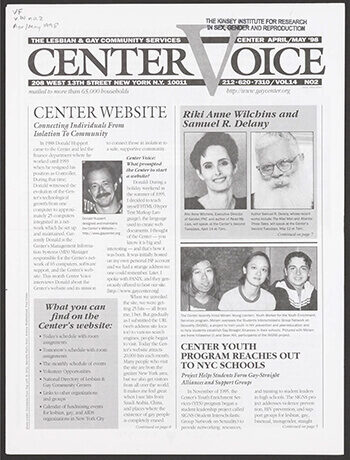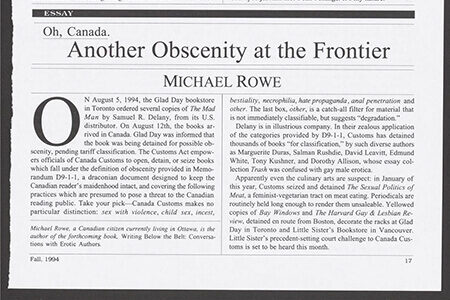Brass Orchids: Sex and Relationships in Samuel R Delany
Samuel R. Delany’s science-fiction masterpiece Dhalgren telling the story of ‘the Kid’, an amnesiac author lost in the terrifyingly surreal city of Bellona, was published in January 1975. Sexuality, relationships and sex are central to the narrative of Dhalgren and Delany’s other fiction; and the recent publication of Sex and Sexuality inspired me to write today about this most intriguing of classic science-fiction authors.
Delany was born in New York in 1942. Openly gay since adolescence, he nevertheless married poet Marylin Hacker on a trip to Detroit – Michigan being one of just two states where they could then legally marry due to age-of-consent laws and because he was African-American and she was white. They divorced in 1980, Hacker since identifying as lesbian.

Miscellaneous Sex Organizations (Folder 1), 13 Sep 1975 - Mar 2011, © Copyright 2017, The Trustees of Indiana University on behalf of the Kinsey Institute. Some material also sourced from the Collections of the Kinsey Institute, Indiana University. All rights reserved.
Delany often uses his writing to explore his sexuality and personal relationships. For instance, his early works frequently delved into his complicated relationship with Hacker and their mutual friend and lover, Bob Folsom. Perhaps this is most overt in Delany’s 1966 novel Babel-17. Rydra Wong, the protagonist of Babel-17, is closely based on Hacker; Delany and Folsom cameo as ‘Muels Aranlyde’ and ‘Fobo Lombs’, Rydra’s former partners whom she reminisces about in an emotionally charged scene. Babel-17’s dedication to Folsom – “to explain just a little of the last year” – gives an important hint as to the purpose of these cameos: Delany, through his fiction, is hoping to clarify aspects of this relationship, either to himself or to others.
There are surely parallels between this and the many members of public who wrote to Alfred Kinsey and Paul Gebhard seeking answers or reassurances regarding their sexuality. These letters, which feature in Sex and Sexuality, tell of personal stories, experiences and questions. Many wrote without expecting a response: like Delany, these correspondents used writing as a means to delve into their relationships.

Homosexuality (Folder 1), 1899-1995, © Copyright 2017, The Trustees of Indiana University on behalf of the Kinsey Institute. All rights reserved.
If many of Delany’s novels are introspective, looking inwards at his personal life and sexuality, others look outwards at sex in broader society. The Einstein Intersection, written in 1967 when anti-normative movements were perhaps at their peak, serves as a commentary on the oppressive nature of norms; and the brutal and violent depictions of sex in Hogg, first written in 1969 but not published until 1995, provide an outlet for Delany’s hostility towards a heterosexist society. Alternatively, The Tale of Plagues and Carnivals (1984) and The Mad Man (1994) each confront the AIDS crisis. These concerns voiced in these last books are mirrored in a series of letters from members of the public to June Reinisch’s Kinsey Report, included in Sex and Sexuality, expressing fears about AIDS.
For more information about Sex and Sexuality, including booking a demo and price enquiries, please email us at info@amdigital.co.uk.
Recent posts

The blog highlights American Committee on Africa, module II's rich documentation of anti-apartheid activism, focusing on the National Peace Accord, global solidarity, and student-led divestment campaigns. It explores the pivotal role of universities, protests, and public education in pressuring institutions to divest from apartheid, shaping global attitudes toward social justice and reform.

This blog examines how primary sources can be used to trace the impact of young voices on society, particularly during pivotal voting reforms in the UK and the US. Explore materials that reveal insights into youth activism, intergenerational gaps, and societal perceptions, highlighting their interdisciplinary value for studying youth culture, activism, and girlhood across history.
